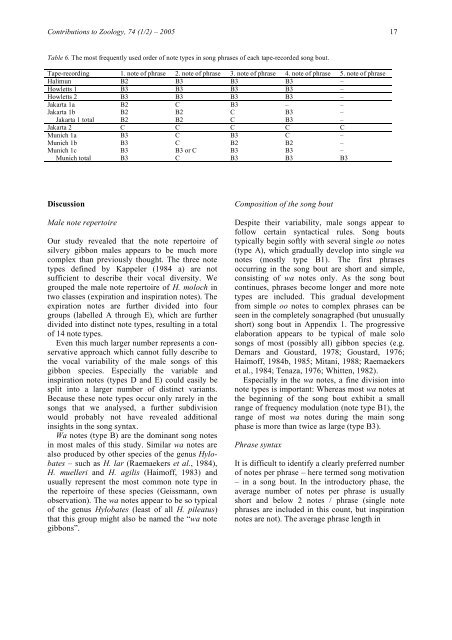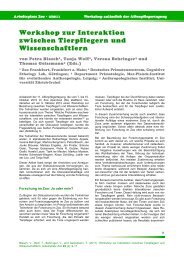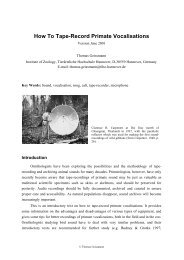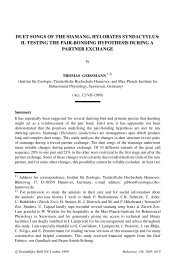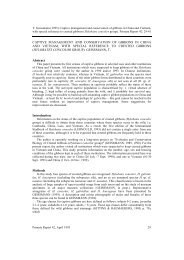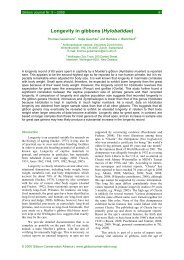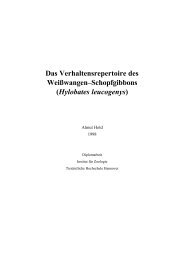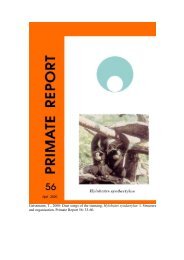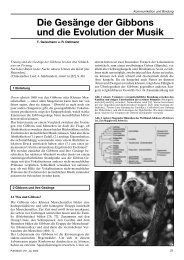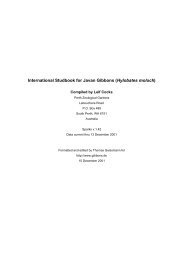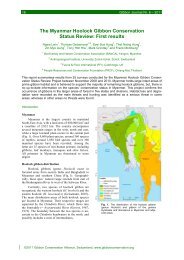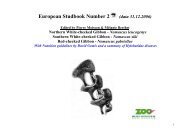The male song of the Javan silvery gibbon (Hylobates moloch)
The male song of the Javan silvery gibbon (Hylobates moloch)
The male song of the Javan silvery gibbon (Hylobates moloch)
- No tags were found...
You also want an ePaper? Increase the reach of your titles
YUMPU automatically turns print PDFs into web optimized ePapers that Google loves.
Contributions to Zoology, 74 (1/2) – 2005 17Table 6. <strong>The</strong> most frequently used order <strong>of</strong> note types in <strong>song</strong> phrases <strong>of</strong> each tape-recorded <strong>song</strong> bout.Tape-recording 1. note <strong>of</strong> phrase 2. note <strong>of</strong> phrase 3. note <strong>of</strong> phrase 4. note <strong>of</strong> phrase 5. note <strong>of</strong> phraseHalimun B2 B3 B3 B3 –Howletts 1 B3 B3 B3 B3 –Howletts 2 B3 B3 B3 B3 –Jakarta 1a B2 C B3 – –Jakarta 1b B2 B2 C B3 –Jakarta 1 total B2 B2 C B3 –Jakarta 2 C C C C CMunich 1a B3 C B3 C –Munich 1b B3 C B2 B2 –Munich 1c B3 B3 or C B3 B3 –Munich total B3 C B3 B3 B3DiscussionMale note repertoireOur study revealed that <strong>the</strong> note repertoire <strong>of</strong><strong>silvery</strong> <strong>gibbon</strong> <strong>male</strong>s appears to be much morecomplex than previously thought. <strong>The</strong> three notetypes defined by Kappeler (1984 a) are notsufficient to describe <strong>the</strong>ir vocal diversity. Wegrouped <strong>the</strong> <strong>male</strong> note repertoire <strong>of</strong> H. <strong>moloch</strong> intwo classes (expiration and inspiration notes). <strong>The</strong>expiration notes are fur<strong>the</strong>r divided into fourgroups (labelled A through E), which are fur<strong>the</strong>rdivided into distinct note types, resulting in a total<strong>of</strong> 14 note types.Even this much larger number represents a conservativeapproach which cannot fully describe to<strong>the</strong> vocal variability <strong>of</strong> <strong>the</strong> <strong>male</strong> <strong>song</strong>s <strong>of</strong> this<strong>gibbon</strong> species. Especially <strong>the</strong> variable andinspiration notes (types D and E) could easily besplit into a larger number <strong>of</strong> distinct variants.Because <strong>the</strong>se note types occur only rarely in <strong>the</strong><strong>song</strong>s that we analysed, a fur<strong>the</strong>r subdivisionwould probably not have revealed additionalinsights in <strong>the</strong> <strong>song</strong> syntax.Wa notes (type B) are <strong>the</strong> dominant <strong>song</strong> notesin most <strong>male</strong>s <strong>of</strong> this study. Similar wa notes arealso produced by o<strong>the</strong>r species <strong>of</strong> <strong>the</strong> genus <strong>Hylobates</strong>– such as H. lar (Raemaekers et al., 1984),H. muelleri and H. agilis (Haim<strong>of</strong>f, 1983) andusually represent <strong>the</strong> most common note type in<strong>the</strong> repertoire <strong>of</strong> <strong>the</strong>se species (Geissmann, ownobservation). <strong>The</strong> wa notes appear to be so typical<strong>of</strong> <strong>the</strong> genus <strong>Hylobates</strong> (least <strong>of</strong> all H. pileatus)that this group might also be named <strong>the</strong> “wa note<strong>gibbon</strong>s”.Composition <strong>of</strong> <strong>the</strong> <strong>song</strong> boutDespite <strong>the</strong>ir variability, <strong>male</strong> <strong>song</strong>s appear t<strong>of</strong>ollow certain syntactical rules. Song boutstypically begin s<strong>of</strong>tly with several single oo notes(type A), which gradually develop into single wanotes (mostly type B1). <strong>The</strong> first phrasesoccurring in <strong>the</strong> <strong>song</strong> bout are short and simple,consisting <strong>of</strong> wa notes only. As <strong>the</strong> <strong>song</strong> boutcontinues, phrases become longer and more notetypes are included. This gradual developmentfrom simple oo notes to complex phrases can beseen in <strong>the</strong> completely sonagraphed (but unusuallyshort) <strong>song</strong> bout in Appendix 1. <strong>The</strong> progressiveelaboration appears to be typical <strong>of</strong> <strong>male</strong> solo<strong>song</strong>s <strong>of</strong> most (possibly all) <strong>gibbon</strong> species (e.g.Demars and Goustard, 1978; Goustard, 1976;Haim<strong>of</strong>f, 1984b, 1985; Mitani, 1988; Raemaekerset al., 1984; Tenaza, 1976; Whitten, 1982).Especially in <strong>the</strong> wa notes, a fine division intonote types is important: Whereas most wa notes at<strong>the</strong> beginning <strong>of</strong> <strong>the</strong> <strong>song</strong> bout exhibit a smallrange <strong>of</strong> frequency modulation (note type B1), <strong>the</strong>range <strong>of</strong> most wa notes during <strong>the</strong> main <strong>song</strong>phase is more than twice as large (type B3).Phrase syntaxIt is difficult to identify a clearly preferred number<strong>of</strong> notes per phrase – here termed <strong>song</strong> motivation– in a <strong>song</strong> bout. In <strong>the</strong> introductory phase, <strong>the</strong>average number <strong>of</strong> notes per phrase is usuallyshort and below 2 notes / phrase (single notephrases are included in this count, but inspirationnotes are not). <strong>The</strong> average phrase length in


